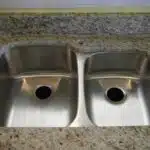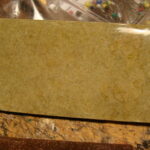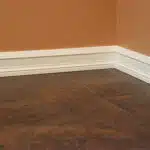As a professional cleaning specialist, one of the most common challenges I encounter is cloudy glass. Whether it’s on windows, mirrors, or even drinking glasses, this unsightly film can be frustrating to deal with and difficult to remove. However, with the right techniques and tools at your disposal, cleaning cloudy glass doesn’t have to be a daunting task.
In this article, we will explore the various causes of cloudy glass and provide practical solutions for restoring its clarity. From simple household remedies to specialized cleaning products, we’ll help you achieve sparkling clean glass surfaces that not only look great but also promote a healthy living environment. So whether you’re a homeowner seeking to enhance the beauty of your living space or a business owner looking to impress clients with spotless windows, read on for our expert tips on how to clean cloudy glass.
Understanding The Causes Of Cloudy Glass
Cloudy glass can be a frustrating and unsightly problem in any home. Understanding the causes of cloudy glass is the first step towards solving this issue. One common cause of cloudy glass is condensation, which occurs when warm air comes into contact with cold glass surfaces. This can happen in areas like bathrooms or kitchens where steam and humidity are present.
Another cause of cloudy glass is the buildup of grime and residue on the surface. This can occur over time as dust, dirt, and other particles settle on the glass, creating a hazy appearance. Preventing buildup by regularly cleaning your windows or other glass surfaces can help to keep them looking clear and bright.
It’s important to note that different types of glass may require different cleaning methods depending on their composition. Identifying the type of glass you are dealing with before attempting to clean it can prevent damage or further cloudiness. In the next section, we will discuss how to identify different types of glass so that you can choose an appropriate cleaning method.
Identifying The Type Of Glass
According to a survey conducted by Statista, the global glass market size was valued at $140.08 billion in 2019, with the packaging sector accounting for the largest share of revenue. Glass is a versatile and popular material that has several applications, ranging from construction and automotive industries to household items like glasses and mirrors. However, not all types of glass are created equal, and it is essential to identify the type of glass before cleaning it.
Identifying glass types is crucial because different types of glass have varying compositions that require specific cleaning techniques. Understanding glass composition can help determine how to clean it safely without causing damage or cloudiness. For example, tempered glass used in mobile phone screens is more durable than ordinary window glass because it undergoes a special heating process during manufacturing.
Here are five common types of glass that require different cleaning methods:
- Window Glass: This type of glass is used in windows and doors and can be easily identified as clear or tinted.
- Decorative Glass: This includes stained or etched glass commonly found in churches or as home decor.
- Tempered Glass: Often used in car windows, shower doors, and mobile phone screens due to its durability after undergoing a special manufacturing process.
- Mirrored Glass: This type of glass has a reflective coating on one side often found in bathroom vanities or decorative items.
- Antique Glass: Dating back centuries; this type of glass requires specialized cleaning methods due to its age and delicate nature.
Understanding the differences between these types of glasses will help determine which cleaning solution works best for each type without causing any damage. In subsequent sections, we will discuss how to choose the right cleaning solution for each specific type of glass.
Choosing The Right Cleaning Solution
Choosing the right cleaning solution is vital in ensuring that your cloudy glass will be thoroughly cleaned. There are different types of cleaning solutions available in the market, and not all of them are suitable for your glassware. Using the wrong cleaning solution can lead to more damage and further clouding.
One common mistake in choosing a cleaning solution is assuming that all glassware requires the same type of cleaner. This assumption can lead to using harsh chemicals or abrasive substances that can scratch or damage your glassware. To avoid this, it is essential to identify the type of glass you have before purchasing any cleaning product.
To help you select the right cleaning solution, here’s a table showing the different types of glasses and their corresponding recommended cleaners:
| Type of Glass | Recommended Cleaner |
|---|---|
| Crystal | Mild detergent or vinegar-based solution |
| Tempered Glass | Non-abrasive cleaner or mild soap with warm water |
| Frosted Glass | Vinegar and water or baking soda paste |
By choosing the appropriate cleaner according to your glass type, you can prevent further clouding and damage while effectively removing any existing haze. Avoiding common mistakes in selecting a cleaning solution is crucial in maintaining clear and sparkling glasses that are perfect for use anytime.
Transition: Now that we’ve established the importance of selecting the right cleaning solution, let’s move on to one effective method known as using vinegar and water.
Using Vinegar And Water
In order to effectively clean cloudy glass, it is important to first choose the right cleaning solution. Vinegar and water is a popular choice for many people due to its effectiveness and affordability. However, there are also other vinegar alternatives available that can be just as effective in restoring the clarity of your glass.
Here are three vinegar alternatives that you can use for cleaning cloudy glass:
Lemon juice: The acidic nature of lemon juice makes it an effective cleaner for removing dirt and grime from glass surfaces. Simply mix equal parts of lemon juice and water in a spray bottle, spray onto the glass surface, and wipe clean with a microfiber cloth.
Club soda: The carbonation in club soda can help to break down stubborn stains on glass surfaces. Pour some club soda onto a cloth and gently scrub the affected area until the stain disappears.
Rubbing alcohol: This is an excellent alternative for those who do not want to use vinegar or lemon juice on their glass surfaces. Mix equal parts rubbing alcohol and water in a spray bottle, spray onto the glass surface, and wipe clean with a lint-free cloth.
If you prefer DIY glass cleaning recipes, there are many options available online that use natural ingredients such as baking soda and essential oils. These recipes not only effectively clean your glass but also provide a pleasant scent without any harsh chemicals.
Using baking soda and water is another effective way to clean cloudy glass. Stay tuned for the next section where we will discuss how to use this method for restoring clarity to your glass surfaces.
Using Baking Soda And Water
Baking soda is a versatile household item that can be used for many cleaning purposes, including cleaning cloudy glass. One of the benefits of using baking soda to clean glass is that it is a gentle abrasive that can remove dirt, grime, and grease without scratching or damaging the surface of the glass. Additionally, baking soda is non-toxic and eco-friendly, making it a safe option for households with children and pets.
When mixing baking soda with water to clean cloudy glass, it’s important to get the ratio right. Too much baking soda can leave a residue on the glass, while too little may not be effective at removing tough stains. A good rule of thumb is to mix one tablespoon of baking soda with one cup of warm water. Stir well until the baking soda has dissolved completely.
To use this mixture to clean cloudy glass, simply dip a soft cloth or sponge into the solution and rub gently in circular motions over the surface of the glass. Pay extra attention to areas with heavy build-up or staining. Rinse thoroughly with warm water and dry with a clean, lint-free cloth. With these tips in mind, you can effectively restore your cloudy glass to its former clarity using just baking soda and water.
Moving forward, if you have particularly stubborn stains on your glass surfaces that won’t come off with just water and baking soda alone, there are other methods you can try. One effective option is using rubbing alcohol mixed with water to break down tough stains and grime on your cloudy glasses. With some simple household items and tricks up your sleeve, achieving crystal-clear glasses is possible!
Using Rubbing Alcohol And Water
Rubbing alcohol mixed with water is an effective solution to clean cloudy glass. The alcohol acts as a solvent, breaking down any buildup on the glass surface, while the water dilutes it. To create this solution, mix one part rubbing alcohol with three parts water. Be sure to use a clean container and stir well before use.
When cleaning cloudy glass with rubbing alcohol and water, it’s important to apply the solution using a non-abrasive cloth or sponge. Avoid using paper towels or abrasive materials that can scratch the glass surface. Begin by wiping down the glass with the solution, applying gentle pressure in circular motions until all areas have been covered. Next, rinse the glass thoroughly with warm water and dry it using a clean microfiber cloth.
While rubbing alcohol and water is an effective solution for cleaning cloudy glass, there are alternative solutions that can be used depending on the severity of the cloudiness. Mixing ratios may need to be adjusted for tougher stains or buildup on the glass surface. For instance, increasing the concentration of rubbing alcohol can improve its efficacy against stubborn stains. Other alternatives include vinegar and baking soda solutions or commercial glass cleaners specifically designed for cloudy glasses.
Using Commercial Glass Cleaners
1.When selecting a commercial glass cleaner, it is important to consider the type of glass, any dirt or debris present, and the cleaning product’s ingredients. 2.When using the cleaner correctly, it is important to follow the directions on the label and only use the recommended amount, as using too much cleaner can result in a residue being left behind. 3.It is also important to understand the safety precautions associated with the product, such as any chemical warnings and the need for protective clothing or eyewear. 4.When cleaning cloudy glass, it is important to use a cleaner that is designed for removing stubborn dirt and debris. 5.The cleaner should be applied to the glass in a circular motion and then allowed to sit for the amount of time recommended by the manufacturer. 6.Once the cleaner has been allowed to sit, the glass should be wiped with a clean, soft cloth and then rinsed with warm water.
Choosing The Right Cleaner
Keeping glass surfaces clean and clear can be a challenging task, especially when they become cloudy. To address this problem, choosing the right cleaner is crucial. When using commercial glass cleaners, it’s important to consider various factors to ensure effective cleaning techniques and safety measures.
Firstly, you must choose a cleaner that is specifically designed for glass surfaces. Avoid using abrasive cleaners or those that contain ammonia or bleach as these can cause damage and leave streaks on the glass. Look for a cleaner that is pH neutral or slightly acidic as these are less likely to cause any harm. Additionally, avoid using paper towels or abrasive materials when cleaning the glass surface as these can scratch and damage the surface.
Secondly, always read and follow the instructions on the label of the cleaner before use. Wear gloves and protective eyewear if necessary to prevent skin irritation or eye damage. Ensure proper ventilation by opening windows or turning on fans in poorly ventilated areas during cleaning. Lastly, do not mix different types of cleaners together as this may cause hazardous chemical reactions.
In conclusion, selecting the right cleaner is an essential step in effectively cleaning cloudy glass surfaces while ensuring safety measures are in place. By following proper cleaning techniques and taking necessary precautions, you can maintain crystal clear glass surfaces that will last for years to come.
Using The Cleaner Correctly
After selecting the right cleaner for glass surfaces, it is equally important to use it correctly to achieve the desired results. Proper storage of the cleaner is essential to maintain its effectiveness. Always store the cleaner in a cool and dry place away from direct sunlight or heat sources. Exposure to high temperatures or freezing can affect the quality of the cleaner, rendering it less effective.
Preventative measures should also be taken when using commercial glass cleaners. Before applying the cleaner, remove any loose debris or dust from the surface with a soft brush or cloth. This prevents scratching during cleaning and ensures that all dirt and grime are removed efficiently. When using a spray bottle, ensure that it is held upright to prevent droplets from landing on unintended surfaces such as carpets or furniture.
Lastly, remember to follow proper cleaning techniques when using commercial glass cleaners. Apply the cleaner evenly over the surface and let it sit for a few seconds before wiping off with a clean microfiber cloth. It’s important not to let the cleaner dry on the surface as this may leave streaks or residue behind. Additionally, avoid cleaning windows on hot days as this can cause rapid evaporation of the cleaner which may result in streaks and hazy surfaces.
By following these guidelines, you will be able to use commercial glass cleaners effectively while preventing damage to your glass surfaces and surroundings. Remember that prevention is always better than cure, so take necessary precautions before cleaning your glass surfaces for optimal results every time.
Cleaning With Safety In Mind
As a professional cleaning specialist, using commercial glass cleaners comes with safety precautions to ensure the well-being of everyone involved. While these cleaners are effective in removing dirt and grime from glass surfaces, they also present potential hazards if not used correctly. Safety should always be a top priority when handling any cleaning product, especially those containing harsh chemicals.
It is important to read the label and instructions carefully before using commercial glass cleaners. This will give you an understanding of how to use the product safely. Some products may require protective gear such as gloves or eyewear to prevent chemical burns or irritation. It’s also advisable to keep children and pets away from the area being cleaned until the surface is completely dry.
When cleaning with safety in mind, it’s essential to keep potential hazards in mind such as slips and falls. Some cleaners can leave surfaces slippery, making them hazardous to walk on. Additionally, avoid overreaching when cleaning high windows or surfaces that require ladders or step stools for access. Always ensure that your equipment is secure and stable before climbing up to clean the surface. By taking these precautions, you’ll be able to use commercial glass cleaners safely while achieving optimal results every time.
Avoiding Abrasive Cleaners
Ironically, commercial glass cleaners may not be the best solution for cleaning cloudy glass. Although they claim to provide a streak-free shine, they often contain harsh chemicals that can damage the surface and exacerbate the cloudiness. As a professional cleaning specialist, it is important to emphasize the importance of avoiding abrasive cleaners in order to protect your glassware.
Instead of relying on harsh chemicals, consider using eco-friendly alternatives such as vinegar or lemon juice mixed with water. These natural solutions are just as effective at cutting through grime and leaving your glassware sparkling clean without harming the environment. Additionally, microfiber cloths are an excellent tool for gentle yet thorough cleaning. They are soft enough not to scratch delicate surfaces while still being effective at removing dirt and grime.
By avoiding harsh chemicals and opting for eco-friendly alternatives, you can ensure that your glassware remains clear and free from cloudiness. With the help of a microfiber cloth and some natural cleaning solutions, you can achieve a streak-free shine while staying environmentally conscious. In the next section, we will explore the benefits of using a microfiber cloth in more detail.
Using A Microfiber Cloth
When it comes to cleaning cloudy glass, using a microfiber cloth can prove to be highly effective. Microfiber cloths are made from a blend of polyester and nylon, which gives them their unique cleaning properties. They are designed to trap dirt and dust particles within the fibers, making them more efficient at cleaning surfaces than regular cotton cloths.
There are several benefits of using a microfiber cloth for cleaning cloudy glass. Firstly, they are reusable and washable, which makes them an eco-friendly option. Regular cotton cloths tend to leave behind lint and streaks on glass surfaces, but microfiber cloths do not shed fibers or leave any streaks behind. Secondly, they are highly absorbent and can hold up to seven times their weight in water, which means that they can effectively clean glass surfaces without leaving any moisture behind. Lastly, microfiber cloths are gentle on delicate surfaces such as glass and can clean without scratching or damaging the surface.
It is important to note the differences between microfiber and regular cloths for cleaning. Regular cotton cloths tend to push dirt around on surfaces rather than picking it up due to their larger fibers. This can make it difficult to clean stubborn stains or marks from glass surfaces. On the other hand, microfiber cloths have smaller fibers that attract dirt particles and remove them from the surface being cleaned. This makes them ideal for cleaning cloudy glass as they can effectively remove built-up grime without leaving any residue behind.
Transition: Now that we understand the benefits of using a microfiber cloth for cleaning cloudy glass and how it differs from regular cotton cloths, let’s move onto another technique that can help achieve crystal-clear results – using a squeegee.
Using A Squeegee
- Prior to using a squeegee for cleaning glass, it is important to ensure the squeegee is properly prepared.
- The most effective technique for using a squeegee involves dragging it in one direction from top to bottom.
- Additionally, the blade must be wiped regularly with a dry cloth to remove any accumulated buildup.
- A cleaning solution that contains a mixture of soap and water is recommended for removing cloudy residue.
- Additionally, rubbing alcohol can be used to remove stubborn stains, but it should be used sparingly and with caution.
- For best results, the cleaning solution should be sprayed onto the glass before being wiped away with the squeegee.
Preparing The Squeegee
Glass windows and surfaces can be a beautiful addition to any home or office, but they can quickly lose their luster when they become cloudy. While many people resort to harsh chemicals and expensive cleaning solutions, using a squeegee can be an effective and affordable way to clean cloudy glass. However, it is essential to properly prepare the squeegee before beginning the cleaning process.
Cleaning tools are crucial for achieving a spotless result when cleaning glass surfaces with a squeegee. The primary tool needed for this task is a high-quality squeegee that has a sharp rubber blade. Before using the squeegee, it is also important to ensure that it is clean and free of dust or debris that may scratch the glass surface. Additionally, having a bucket of warm water mixed with mild soap and a microfiber cloth on hand will help remove any dirt or grime from the glass surface.
Proper technique is equally as important as having the correct cleaning tools when using a squeegee to clean cloudy glass. To begin, wet the glass surface with the soapy water mixture and use the microfiber cloth to gently scrub away any dirt or grime. Next, place the squeegee at the top of the glass surface and pull down in one smooth motion while maintaining firm pressure against the glass. Be sure to overlap each stroke slightly to prevent streaks from forming. Repeat this process until all areas of the glass have been cleaned.
In conclusion, preparing your squeegee correctly is crucial when attempting to clean cloudy glass effectively. By having clean tools readily available and utilizing proper technique during each stroke, you can achieve stunning results without damaging your glass surfaces. So next time you’re faced with cloudy windows or mirrors, remember these tips and let your trusty squeegee do the hard work for you!
Squeegee Techniques
When it comes to cleaning glass surfaces, using a squeegee can be an effective tool. However, proper technique is crucial for achieving a spotless result. One important aspect of squeegee technique is having a proper grip on the handle. It is essential to hold the handle firmly but not too tightly to allow for smooth and controlled movements. Additionally, maintaining the correct angle of the squeegee blade against the glass surface is crucial for preventing streaks from forming.
Another important aspect of squeegee technique is maintaining the blade’s condition. A sharp rubber blade is necessary for effectively cleaning cloudy glass surfaces without leaving streaks or scratches behind. To maintain the squeegee blade’s condition, it should be wiped clean after each stroke with a microfiber cloth and periodically replaced when signs of wear appear.
In conclusion, mastering proper squeegee technique includes having a secure grip on the handle and maintaining the correct angle of the blade while ensuring that it remains in good condition. By following these techniques and incorporating them into your cleaning routine, you can achieve stunning results without damaging your glass surfaces. So next time you’re faced with cloudy windows or mirrors, remember these tips and let your trusty squeegee do its job!
Cleaning Solution Options
When it comes to cleaning glass surfaces, using a squeegee can be an effective tool. However, achieving spotless results also depends on the type of cleaning solution used. DIY cleaning solutions are popular among homeowners because they are cost-effective and easy to make from ingredients found in most households. On the other hand, professional cleaning solutions are more potent and specially formulated for tackling tough stains.
DIY cleaning solutions often consist of natural ingredients such as vinegar, lemon juice, and baking soda. While these ingredients may be less harsh than chemical cleaners, they may not always be effective at removing stubborn dirt and grime. Additionally, some natural ingredients may leave streaks or cause damage to certain types of glass surfaces. Professional cleaning solutions contain powerful chemicals that can break down even the toughest stains without damaging the glass surface.
When deciding between DIY vs professional cleaning solutions for use with a squeegee, it is important to consider the level of expertise required. While DIY solutions may seem like a straightforward option, improper mixing or application can lead to unsatisfactory results or even damage your glass surfaces. Professional cleaners have the knowledge and experience needed to choose the right solution for each type of glass surface and apply it safely and effectively. Ultimately, choosing between natural vs chemical solutions depends on your priorities in terms of effectiveness and safety.
Drying The Glass Properly
So you’ve successfully cleaned your cloudy glass and it’s looking crystal clear. Now, it’s time to dry it properly. Many people make the mistake of air drying their glass, but this can actually cause more cloudiness. The key to drying your glass is proper towel usage.
Firstly, you must ensure that you’re using a clean towel. Any dirt or residue left on the towel can transfer back onto the glass and undo all your hard work. Secondly, use a soft, lint-free towel to avoid leaving any scratches or marks on the glass surface.
When drying the glass, start from the top and work your way down to avoid any drips or streaks. Gently wipe the surface with the towel in a circular motion until all moisture is removed. If there are any hard-to-reach spots, use a microfiber cloth or cotton swab to get into those areas.
Remember to always avoid air drying as this can leave water spots and streaks on your newly cleaned glass. Proper towel usage is key to achieving a spotless finish every time. In our next section, we’ll discuss how to prevent future cloudiness so that you can enjoy your sparkling clean glass for longer periods without having to repeat the cleaning process again and again.
Preventing Future Cloudiness
To prevent future cloudiness on your glassware, it is important to take proper care of them. One way to avoid scratches that can lead to cloudy appearance is by using soft sponges or microfiber cloths when cleaning. Abrasive materials such as steel wool and harsh chemicals should be avoided at all costs.
Proper storage techniques can also contribute to the longevity of your glassware’s clarity. Avoid stacking glasses on top of each other without any protective layers in between as this can cause scratches and chips. Instead, invest in a dedicated space for your glassware where they can be stored individually with enough breathing room.
By following these preventative measures, you can extend the life and clarity of your glassware. However, regular maintenance tips are still necessary to keep them looking their best. In the next section, we will discuss some simple yet effective steps you can take to ensure that your glassware remains crystal clear for years to come.
Regular Maintenance Tips
To prevent future cloudiness, it is important to take measures to protect your glassware from scratches. Scratches on the surface of the glass can cause small imperfections that can trap dirt and grime, leading to cloudy glass in the long run. To avoid this, it is recommended that you use soft cloths or microfiber towels instead of abrasive materials like steel wool or harsh scrub brushes when cleaning your glassware.
Long term effects can also be prevented by taking regular care of your glassware. This involves washing them immediately after use, as leaving them unwashed for prolonged periods can lead to a buildup of mineral deposits and other substances that are difficult to remove. Additionally, it is important to dry your glasses thoroughly after washing them as any residual moisture can lead to cloudiness over time.
In summary, preventing future cloudiness and maintaining clear glassware requires proper cleaning practices and being mindful of potential long-term effects. By avoiding scratches and taking regular care of your glasses, you can ensure their longevity and clarity. However, if all else fails and you are left with cloudy glass despite your best efforts, seeking professional help may be necessary.
Seeking Professional Help
When it comes to cleaning cloudy glass, sometimes the best solution is to seek professional help. Finding experts in glass cleaning may take some research, but it can ultimately save time and ensure that the job is done correctly. Look for professionals who have experience in cleaning different types of glass surfaces and who use high-quality equipment and cleaning solutions.
One factor to consider when seeking professional help is the cost of professional cleaning. Depending on the extent of the cloudiness and the size of the surface area, professional glass cleaning services can range from a few hundred dollars to several thousand dollars. It is important to obtain quotes from multiple companies and compare their prices and services before making a decision. It may also be helpful to read reviews from past customers or ask for recommendations from friends or family.
In some cases, troubleshooting common issues with cloudy glass may be necessary even after seeking professional help. For example, if there are hard water stains on the glass surface, it may be necessary to adjust water softener settings or use a specialized cleaner. By following proper maintenance techniques and addressing any underlying issues, you can prevent future cloudiness and keep your glass surfaces looking clear and beautiful for years to come.
Troubleshooting Common Issues
Like a foggy morning, cloudy glass can be frustrating to look through. It can be caused by a buildup of residue or mineral deposits that accumulate over time. Fortunately, there are ways to restore your glass and make it clear again.
Prevention methods are key when it comes to keeping glass from becoming cloudy. Using distilled water to clean your glassware can prevent mineral buildup from tap water, which causes cloudiness. Hand washing with mild soap and warm water is also recommended, as dishwashers can leave behind harsh chemicals that damage the surface of the glass.
If you find yourself faced with cloudy glass, there are several DIY remedies that you can try before seeking professional help. One option is soaking the glass in a mixture of vinegar and warm water for several hours before rinsing thoroughly with cool water. Another method involves using baking soda as a gentle abrasive to scrub away any buildup on the surface of the glass. For particularly stubborn stains, lemon juice and salt can be combined to create a paste that is applied directly onto the affected area.
Cloudy glass doesn’t have to be a permanent problem. With proper prevention methods and simple DIY remedies, you can restore your glasses to their original clarity and enjoy crystal-clear views once again.
Conclusion
Cloudy glass can be a frustrating and unsightly issue that plagues many households. As a professional cleaning specialist, it is important to understand the causes of cloudy glass and how to effectively clean it. The first step is identifying the type of glass as different glasses require different cleaning solutions.
Once the type of glass has been identified, choosing the right cleaning solution is crucial. Vinegar and water or baking soda and water are effective options for removing cloudiness from glass. Preventing future cloudiness can also be achieved through regular maintenance tips such as avoiding exposure to extreme temperatures.
Despite taking preventative measures, some issues may persist. Seeking professional help should not be overlooked as sometimes a simple fix is needed to restore clarity to your glass. In conclusion, with proper identification, cleaning techniques, and maintenance practices, cloudy glass can become a thing of the past in any household.
Image Credits





























